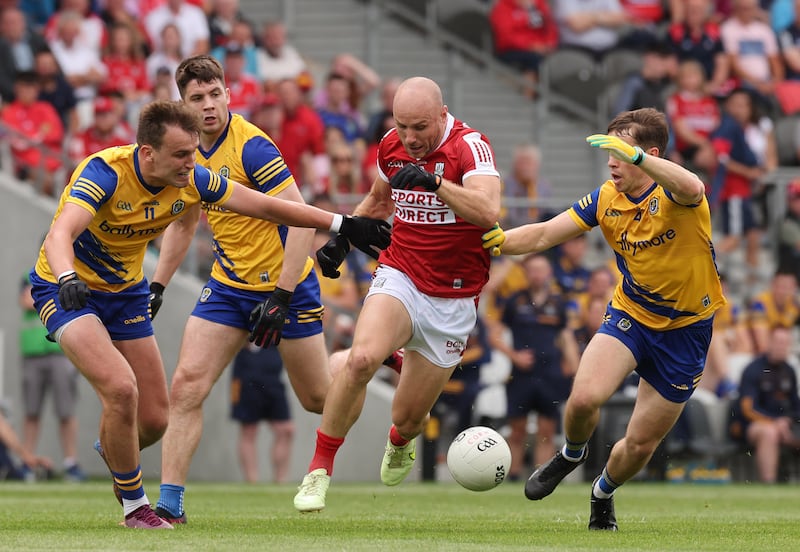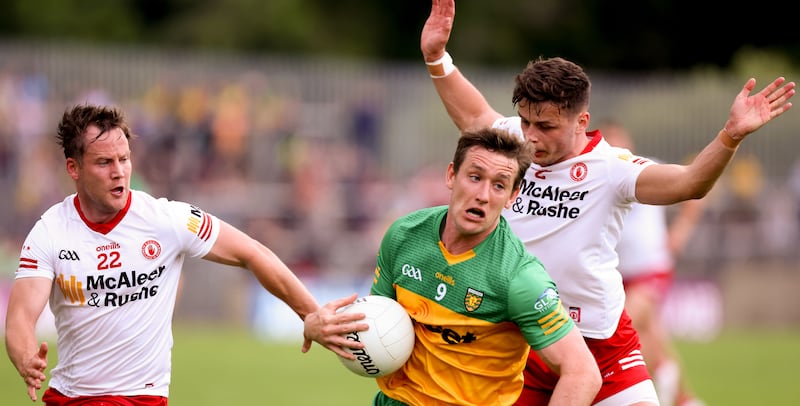As the biggest game of last weekend approached injury-time, Mayo found themselves one point ahead of Galway and in possession of the ball at Pearse Stadium.
If David McBrien’s goal was the crucial score in the contest, the passage of play following Shane Walsh’s pointed free – which left just the minimum between the sides – was equally as pivotal in the outcome.
As the clock struck 69 minutes and 44 seconds, Colm Reape took a short kick-out. For the next two minutes Mayo played keep ball. Galway, needing a score, pushed up the pitch to get pressure on, but Mayo retained their composure and used all of their experience to hold possession.
After two minutes of absorbing Galway’s high pressure, Mayo managed to break from the Tribesmen’s press and inflicted the killer blow via the boot of James Carr, the ball sailing over the crossbar with the clock showing 71 minutes and 44 seconds. It was excellent game management.
Seán Moran: League’s championship promise may be clouding but it remains bright at the top
Malachy Clerkin: The GAA should make more of St Patrick’s Day - and more of its intercounty stars
Sports Review 2023: Mary Hannigan picks the best quotes from the sporting year
GAA happy that GAAGo has ‘bedded in well’ as 2024 season launches
The day before, a similar script played out in the Monaghan-Kildare encounter with the Ulster side having a long spell of possession in injury-time before the move ended with an excellent match-winning point by Conor McCarthy.
It is important, when we look at these passages of play, not to confuse game management with the possession-based style that has provoked so much debate this summer.
Last year’s Ulster final between Donegal and Derry was really the first time that possession-based style in the first and middle third of the pitch was put on show to an Ulster audience.
Derry had their game plan, but Donegal sat and waited inside their own half for them to attack, only they refused to do so. Derry were only prepared to attack on their terms, the consequence of which left a lot of people wondering what was going on. It created a tension in the game and frustrated some of those in attendance as that is not traditionally how Ulster championship games have played out.
Roscommon’s round-robin fixture against Dublin at Croke Park this year also felt like a bit of a watershed moment. Roscommon used prolonged periods of possession to frustrate Dublin. The Dubs were in a man-to-man structure, while Roscommon operated their goalkeeper as an extra player to avoid contact.
The Rossies attempted something similar on Saturday in Páirc Uí Chaoimh, where they tried to bait Cork to come out of their shape. With Roscommon refusing to attack unless that transpired, it resulted in periods of stalemate where nothing really happened at all.

The Cork fans voiced their disapproval by booing each long Roscommon attack. Cork’s management and players didn’t accept the style either, the Rebels went hard after Roscommon’s kick-outs with an aggressive high press.
To be clear, this possession-based style is not merely keeping the ball for the sake of keeping it, it is a tactical innovation. The question is, how did we get here?
Dublin were probably the first team to use possession as a weapon to control opposition teams. There was a period when Dublin had bigger, stronger and more powerful players than many other counties.
They were also technically very proficient, so when Dublin decided to play keep ball it was extremely difficult to wrestle possession away from them. As a result, they would draw teams out of their shape, switch to the weak side and inject pace. It was a tactic that worked incredibly well for several years.
Other teams have now taken that concept, applied the principles underpinning it, but also evolved the tactic to all sectors of the pitch. Derry and Roscommon frequently use it in the first and middle third to create overloads, utilising their goalkeeper as the plus one.
There has been a lot of commentary around the style and there have been suggestions about what possible rule changes could be introduced to address the issue. But for me, tactics have a better chance of limiting the style than rule changes.
When it’s all boiled down, this is about pressure, and specifically exerting pressure on the opposition. That is why Cork were so effective in their game against Roscommon, they kept a high press.
We also witnessed something similar in the Ulster final this year where Armagh denied Derry an easy build-up in the first and middle third of the pitch. Derry normally get close to the opposition defensive 45-metre line pretty much uncontested because of the overload created by their goalkeeper. But Armagh stayed high and made them work incredibly hard to progress the ball.
Ultimately, the ambition for teams is to force the ball into 50-50 scenarios, the more you can do that the better chance you have of disrupting the opposition and creating a situation where they don’t have their hands on the ball.
Another tactic teams could examine is leaving players up the field – as Tyrone demonstrated against Donegal on Saturday.

When Donegal attacked, two Tyrone forwards remained up the field. With players like Ruairí Canavan, Darragh Canavan and Darren McCurry, Tyrone have the scoring threat to really punish opponents if the ball is turned over at the other end of the field, as happened on Saturday, leading to rapid transitions.
It is much more difficult for teams to push their goalkeeper forward in that scenario as well and if two forwards stay in around the opposition goal, then the defensive team must keep players back too.
The crux of it all is to try find a way to ensure the opposition cannot attack on their terms. You achieve that by creating innovative tactics, whether it’s Armagh pushing up and staying high or it’s your own goalkeeper coming out to release another player to push further up, nullifying the impact of the opposition goalkeeper and effectively creating a 15 v 15 scenario.
The last piece of the jigsaw is how you defend yourself. Possession-based football is slow and monotonous, it’s time running down on the clock, which could potentially impact on the possession team’s scoring ratio.
[ Canavans wreak havoc on Donegal as Tyrone make last eightOpens in new window ]
One aspect more than any other that forces managers to rethink strategy, either in real time or in reflection, is failing to keep the scoreboard ticking over.
So, if you can create a situation where they are thinking, this is not worth the while, then you could see managers looking for alternative solutions. A good defence which forces teams in possession to cough up the ball after long passages of play would certainly focus minds.
For me, the defining influencers who will determine where the game is headed are the teams remaining in the race for Sam Maguire – Dublin, Kerry, Derry, Armagh, Mayo, Cork, Monaghan and Tyrone.
The reason for this is because most of what happens in Gaelic football and much of what we will see transpire next year, at club and county level, tends to be derived from the winning formula of the All-Ireland champions.
That is probably why so many teams have adopted this style because Dublin had so much success with it over the years.
The weeks ahead will have a significant impact on next year’s football season.
We have seen some teams are now starting to challenge the status quo in relation to the possession-based game. And for me, if a successful team emerges with a different style and manages to put that possession-based tactic to the sword, 2024 could see Gaelic football shift again in a different trajectory.
















